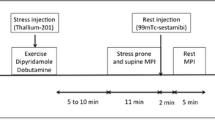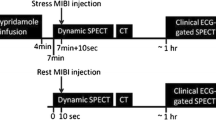Abstract
Background
Myocardial perfusion imaging in conjunction with dipyridamole low-level exercise stress has proved its value in the evaluation of patients with coronary artery disease (CAD). Simultaneous wall motion analysis by two-dimensional (2D) echocardiography may provide additional information beyond that obtained by myocardial perfusion imaging alone. The purpose of this study was to compare 99mTc-labeled sestamibi single-photon emission computed tomography (SPECT) and 2D echocardiography for the evaluation of CAD according to a dipyridamole low-level bicycle exercise stress protocol.
Methods and Results
We studied 35 consecutive patients referred for the evaluation of chest pain who had undergone coronary arteriography. 99mTc-labeled sestamibi SPECT and 2D echocardiography agreed in 27 patients (80%) studied for overall detection of CAD. On a segmental basis, agreement was found between SPECT and 2D echocardiography in 124 (73%) of 170 segments (Cohen’s kappa=0.43). The accuracy of the combined assessment of myocardial perfusion and echocardiographic wall motion in detecting CAD was 86%, which was not different from the accuracy of SPECT alone (80%; difference not significant) but significantly higher than for 2D echocardiography alone (71%; p=0.03). In the detection of individual coronary artery stenoses, SPECT had a significantly higher accuracy for detecting left anterior descending coronary artery lesions than had 2D echocardiography (80% vs 60%; p<0.01); combining the two methods did not improve the accuracy (80%). The combined assessment slightly improved the accuracy for detecting left circumflex coronary artery stenoses from 71% to 83% (p=0.05).
Conclusion
The combined simultaneous assessment of myocardial perfusion by 99mTc-labeled sestamibi SPECT and wall motion by 2D echocardiography did not significantly improve overall accuracy over that obtained by 99mTc-labeled sestamibi SPECT alone. Therefore 99mTc-labeled sestamibi SPECT with dipyridamole low-level exercise stress appears the preferred imaging modality for the evaluation of patients with CAD.
Similar content being viewed by others
References
Boucher CA, Brewster DG, Darling RC, Okada RD, Strauss HW, Pohost GM. Determination of cardiac risk by dipyridamole thallium imaging before vascular surgery. N Engl J Med 1985;312:389–94.
Leppo JA, O'Brien J, Rothendler JA, Getchell JD, Lee VW. Dipyridamole thallium 201 scintigraphy in prediction of future cardiac events after myocardial infarction. N Engl J Med 1984; 310:1014–8.
Aldrich HR, Reichek N. Stress echocardiography. Curr Opin Cardiol 1993;8:978–87.
Armstrong WF. Stress echocardiography for detection of coronary artery disease. Circulation 1991;84(suppl):143–9.
Ignaszewski AP, McCormick LX, Heslip PG, McEwan AJ, Humen DP. Safety and clinical utility of combined intravenous dipyridamole/symptom-limited exercise stress test with thallium-201 imaging in patients with known or suspected coronary artery disease. J Nucl Med 1993;34:2053–61.
Brown A. Exercise-dipyridamole myocardial perfusion imaging: the circle is now complete. J Nucl Med 1993;12:2061–3.
Laarman GJ, Bruschke AVG, Verzijlbergen JF, Bal ET, Van der Wall EE, Ascoop CAPL. Efficacy of intravenous dipyridamole with exercise in thallium-201 myocardial perfusion scintigraphy. Eur Heart J 1988;9:1206–14.
Beller GA. Myocardial perfusion imaging with thallium-201. J Nucl Med 1994;35:674–80.
Laarman GJ, Niemeyer MG, Van der Wall EE, Verzijlbergen FJ, Go TL, Bruschke AVG, et al. Dipyridamole thallium testing: noncardiac side effects, electrocardiographic changes and hemodynamic changes after dipyridamole infusion with and without exercise. Int J Cardiol 1988;20:231–8.
Casale PN, Guiney TE, Strauss HW, Boucher CA. Simultaneous low level treadmill exercise and intravenous dipyridamole stress thallium imaging. Am J Cardiol 1988;62:799–802.
Brown BG, Josephson MA, Petersen RB, Pierce CD, Wong M, Hecht HS, et al. Intravenous dipyridamole combined with isometric handgrip for near maximal acute increase in coronary flow in patients with coronary artery disease. Am J Cardiol 1981;48:1077–85.
Picano E, Lattanzi F, Masini M, Distante A, l'Abbate A. Usefulness of the dipyridamole-exercise echocardiography test for diagnosis of coronary artery disease. Am J Cardiol 1988;62:67–70.
Picano E. Stress echocardiography: from pathophysiological toy to diagnostic tool: point of view. Circulation 1992;85:1604–12.
Najm YC, Timmis AD, Maisey MN, Ellam SV, Mistry R, Curry PV, et al. The evaluation of ventricular function using gated myocardial imaging with Tc-99m MIBI. Eur Heart J 1989;10:142–8.
Verzijlbergen JF, Suttorp MJ, Ascoop CAPL, Zwinderman AH, Niemeyer MD, Van der Wall EE, et al. Combined assessment of technetium-99m-sestamibi planar myocardial perfusion images at rest and during exercise with rest/exercise left ventricular wall motion studies evaluated from gated myocardial perfusion studies. Am Heart J 1992;123:59–68.
Chua T, Kiat H, Germano G, Maurer G, van Train K, Friedman J, et al. Gated technetium-99m sestamibi for simultaneous assessment of stress myocardial perfusion, postexercise regional ventricular function and myocardial viability. J Am Coll Cardiol 1994;23:1107–14.
Cramer MJM, Verzijlbergen JF, Niemeyer MG, Van der Wall EE, Zwinderman AH, Ascoop CAPL, et al. Tc99m sestamibi SPECT with combined dipyridamole and exercise stress in coronary artery disease. Nucl Med Commun 1994;15:554–9.
Cramer MJ, Verzijlbergen JF, Van der Wall EE, Niemeyer MG, Zwinderman AH, Ascoop CAPL, et al. Head-to-head comparison between technetium-99m-sestamibi and thallium 201 tomographic imaging for the detection of coronary artery disease using combined dipyridamole-exercise stress. Coronary Artery Dis 1994;5:787–91.
Machecourt J, Longere P, Fagret D, Vanzetto G, Wolf JE, Polidori C, et al. Prognostic value of thallium-201 SPECT myocardial perfusion imaging according to extent of myocardial defect. J Am Coll Cardiol 1994;23:1096–106.
Zaret BL, Wackers FJ, Soufer R. Nuclear cardiology. In: Braunwald E, editor. Heart disease. 4th ed. Philadelphia: WB Saunders, 1992.
Stamm RB, Gibson RS, Bishop HL, Carabello BA, Beller G, Martin RP. Echocardiographic detection of infarct-localized asynergy and remote asynergy during acute myocardial infarction: correlation with the extent of angiographic coronary artery disease. Circulation 1983;67:233–44.
Jaarsma W, Visser CA, Van Eenige MJ, Roos JP. Predictive value of two-dimensional echocardiographic and hemodynamic measurements on admission with acute myocardial infarction. J Am Soc Echocardiogr 1988;1:187–93.
Okada RD, Glover D, Gaffney T, Williams S. Myocardial kinetics of technetium-99m-hexakis-2-methoxy-2-methylpropylisonitrile. Circulation 1988;77:491–8.
Li Q-S, Solot G, Frank TL, Wagner HN, Jr, Becker LC. Myocardial redistribution of Tc99m-methoxyisobutyl isonitrile (sestamibi). J Nucl Med 1990;31:1069–76.
Taillefer R, Primeau M, Costi P, Lambert R, Léveillé J, Latom Y. Sestamibi myocardial perfusion imaging in detection of coronary artery disease: comparison between initial (1-hour) and delayed (3-hour) post exercise images. J Nucl Med 1991;32:1961–5.
Pozzoli MMA, Fioretti PM, Salustri A, Reijs AEM, Roelandt JRTC. Exercise echocardiography and technetium-99m MIBI SPECT in the detection of coronary artery disease. Am J Cardiol 1991;67:350–5.
Quinones MA, Verani MS, Haichin RM, Mahmarian JJ, Swarez J, Zoghbi WA. Exercise echocardiography versus thallium SPECT in evaluation of coronary artery disease. Circulation 1992;85:1026–31.
Marwick T, D'Hondt A-M, Baudhin T, Willemart B, Wijns B, Detry JM, et al. Optimal use of dobutamine stress for the detection and evaluation of coronary artery disease: combination with echocardiography or scintigraphy or both? J Am Coll Cardiol 1993;22:159–67.
Forster T, McNeill AJ, Salustri A, Reijs AE, el-Said ES, Roelandt JR, et al. Simultaneous dobutamine stress echocardiography and MIBI SPECT in patients with suspected coronary artery disease. J Am Coll Cardiol 1993;21:1591–6.
Marwick T, Willemart B, D'Hondt A-M, Baudhuin T, Wijns W, Detry JM, et al. Selection of the optimal nonexercise stress for the evaluation of ischemic regional myocardial dysfunction and malperfusion: comparison of dobutamine and adenosine using echocardiography and 99mTc-MIBI simple photon emission computed tomography. Circulation 1993;87:345–54.
Amanullah AM, Bevegard S, Lindvall K, Aasa M. Assessment of left ventricular wall motion in angina pectoris by two-dimensional echocardiography and myocardial perfusion by technetium-99m sestamibi tomography during adenosine-induced coronary vasodilation and comparison with coronary angiography. Am J Cardiol 1993;72:983–9.
Ostojic M, Picano E, Beleslin B, Dordjevic-Dihic A, Distante A, Stepanovic J, et al. Dipyridamole-dobutamine echocardiography: a novel test for the detection of milder forms of coronary artery disease. J Am Coll Cardiol 1994;23:1115–22.
Beller GA, Gibson RS. Sensitivity, specificity, and prognostic significance of noninvasive testing for occult or known coronary disease. Prog Cardiovasc Dis 1987;29:241–70.
Picano E, Lattanzi F, Orlandini A, Masini C, L'abbate A. Stress echocardiography and the human factor: the importance of being an expert. J Am Coll Cardiol 1991;17:666–9.
Simek CL, Watson DD, Smith WH, Vinson E, Kaul S. Dipyridamole thallium-201 imaging versus dobutamine echocardiography for the evaluation of coronary artery disease in patients unable to exercise. Am J Cardiol 1993;72:1257–62.
Rahimtoola SH. The hibernating myocardium. Am Heart J 1989; 117:211–21.
Bolli R. Mechanism of myocardial stunning. Circulation 1990;82:723–38.
Homans DC, Sublett E, Dai XZ, Bache RJ. Persistence of regional left ventricular dysfunction after exercise induced myocardial ischemia. J Clin Invest 1986;77:66–73.
Cuocolo A, Maurea S, Pace L, Nicola E, Nappi A, Imbriaco M, et al. Resting technetium-99m sestamibi cardiac imaging in chronic coronary artery disease: comparison with rest-redistribution thallium-201 scintigraphy. Eur J Nucl Med 1993;20:1186–92.
Altehoefer C, Von Dahl J, Biedermann M, Uebis R, Beilin I, Sheehan F, et al. Significance of defect severity in Tc99m-MIBI SPECT at rest to assess myocardial viability: comparison with fluorine-18-FDG PET. J Nucl Med 1994;35:569–74.
Williams KA, Taillon LA. Gated planar technetium-99m labeled sestamibi myocardial perfusion image inversion for qualitative scintigraphic assessment of left ventricular function. J Nucl Cardiol 1995;2:285–95.
Berman DS, Germano G, Kiat H, Friedman J. Simultaneous perfusion/function imaging. J Nucl Cardiol 1995;2:271–3.
Goris ML, Thomson C, Malone CJ, Franken PRI. Modelling the integration of myocardial regional perfusion and function. Nucl Med Commun 1994;15:9–20.
Author information
Authors and Affiliations
Rights and permissions
About this article
Cite this article
Cramer, MJ.M., van der Wall, E.E., Jaarsma, W. et al. Detection of coronary artery disease: Comparison between technetium 99m-labeled sestamibi single-photon emission computed tomography and two-dimensional echocardiography with dipyridamole low-level exercise-stress. J. Nucl. Cardiol. 3, 389–394 (1996). https://doi.org/10.1016/S1071-3581(96)90073-2
Received:
Accepted:
Issue Date:
DOI: https://doi.org/10.1016/S1071-3581(96)90073-2




